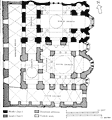|
|



| |
 |
click
images to enlarge |
 |
|
 |
 |
 |
 |
| |
The architecture
of the middle Byzantine period reflects changes in the nature
of Byzantine society starting with the Transitional Period from
the 7th to 9th centuries (plague, famine, Arab invasions, Iconoclast
controversy, deurbanization, a cultural break). These societal
changes led from an open to a closed society, from a public
to a private character of Byzantine life. Developments in the
architecture profession are reflected in the terminology of
the period—a change from theory-based to practice-based.
Modifications in worship practices dictated a smaller-scale
to the buildings to serve private devotion. The symbolic importance
of the dome continued, as with the two-axis, two-focus space
expressed in the Hagia Sophia, but with a dramatic reduction
in scale.
Thessaloniki,
Hagia Sophia. Late 7th century(?), the cathedral of the city.
Smaller scale, with a dome of only ca. 30 ft. in diameter. Structural
problems found in earlier Byzantine architecture were corrected
with the cross-domed system for the naos. The design becomes
more centralized. Introduction of the pastophoria.
Note new terminology: naos,
bema,
prothesis,
diakonikon.



|
|


|
|

 |
|
Thessaloniki,
Hagia Sophia, Isometric diagram, Exterior view from the
northeast
|
 |
Thessaloniki,
Hagia Sophia, Exterior view
|
 |
Thessaloniki,
Hagia Sophia, Interior view facing northwest |
 |

Istanbul, Myrelaion (Budrum Camii) built c. 920. A private family
chapel for Romanos Lekapenos, attached to the palace. Textbook
example of "classical" cross-in-square church, with pyramidal
massing of elements, dome raised on a drum; insistently 3-dimensional
in design. At the same time, there is a balance between components
unified in the whole structure. Articulation of the exterior
reflects the structural and spatial divisions of the interior.
The Small scale is one of the key features of the period.
 Structural
Clarity: Compare Middle Byzantine architecture to Western Romanesque
architecture Structural
Clarity: Compare Middle Byzantine architecture to Western Romanesque
architecture




Istanbul,
Myrelaion (Budrum Cami), Cross-sections and plans of upper
and lower churches
|
 |


Istanbul,
Myrelaion (Budrum Cami), Exterior from the southeast
|



|
 |
The
diagram at the left of a Middle Byzantine sanctuary reflects
changes in the liturgy, with more circular movements,
visual and physical separation of bema. Two performance
areas.
Istanbul, Theotokos of Lips (Fenari Isa Camii). The North
Church was dedicated in 907. Monastic
church constructed for a high court official. The cross-in-square
plan, very similar in date and overall form to the Myrelaion,
incorporates six subsidiary chapels for commemoration,
veneration, and private devotion of the monks. This development
emerges at the same time as the perfected cross-in-square
church design.
 Compare
the subsidiary spaces in Middle Byzantine architecture
to the Westen Medieval chevet. Compare
the subsidiary spaces in Middle Byzantine architecture
to the Westen Medieval chevet.

|


|
|


|
|

 |
|
Istanbul,
Theotokos of Lips (Fenari Isa Cami), Plan

|
 |
Istanbul,
Theotokos of Lips (Fenari Isa Cami), Exterior

|
 |
Istanbul,
Theotokos of Lips (Fenari Isa Cami), Reconstruction view

|
 |
Bibliography
| Robert
Ousterhout. Master Builders of Byzantium. Princeton: Princeton
University Press, 1999 |
 |
| Robert
Ousterhout. "The Holy Space: Architecture and the Liturgy."
Heaven on Earth: Art and the Church in Byzantium. Ed.
Linda Safran. University Park: Pennsylvania State University
Press, 1998, pp. 81–120 |
back
to briefing main
briefing | image
index | resources
home page | site
image index | site resources
media center for art history and archaeology
| columbia university
|
|
|
|
|

